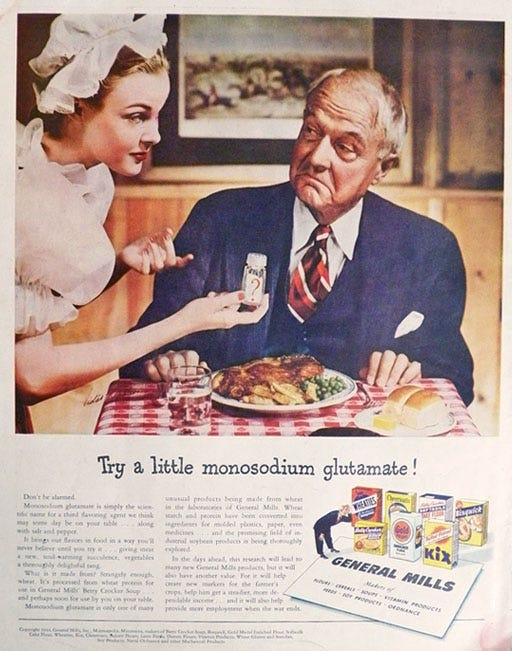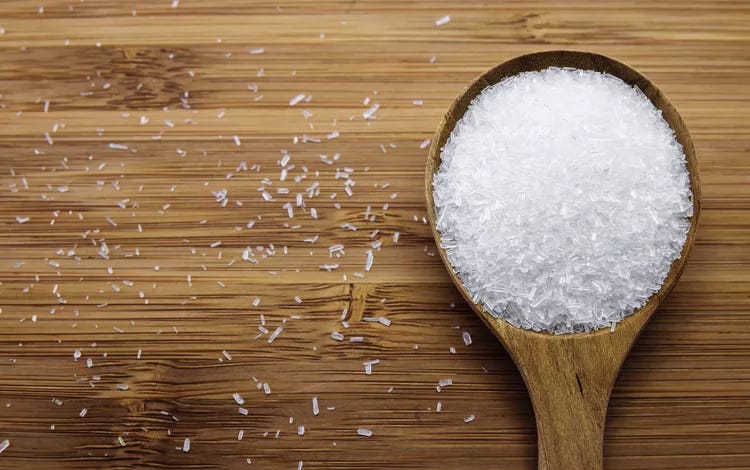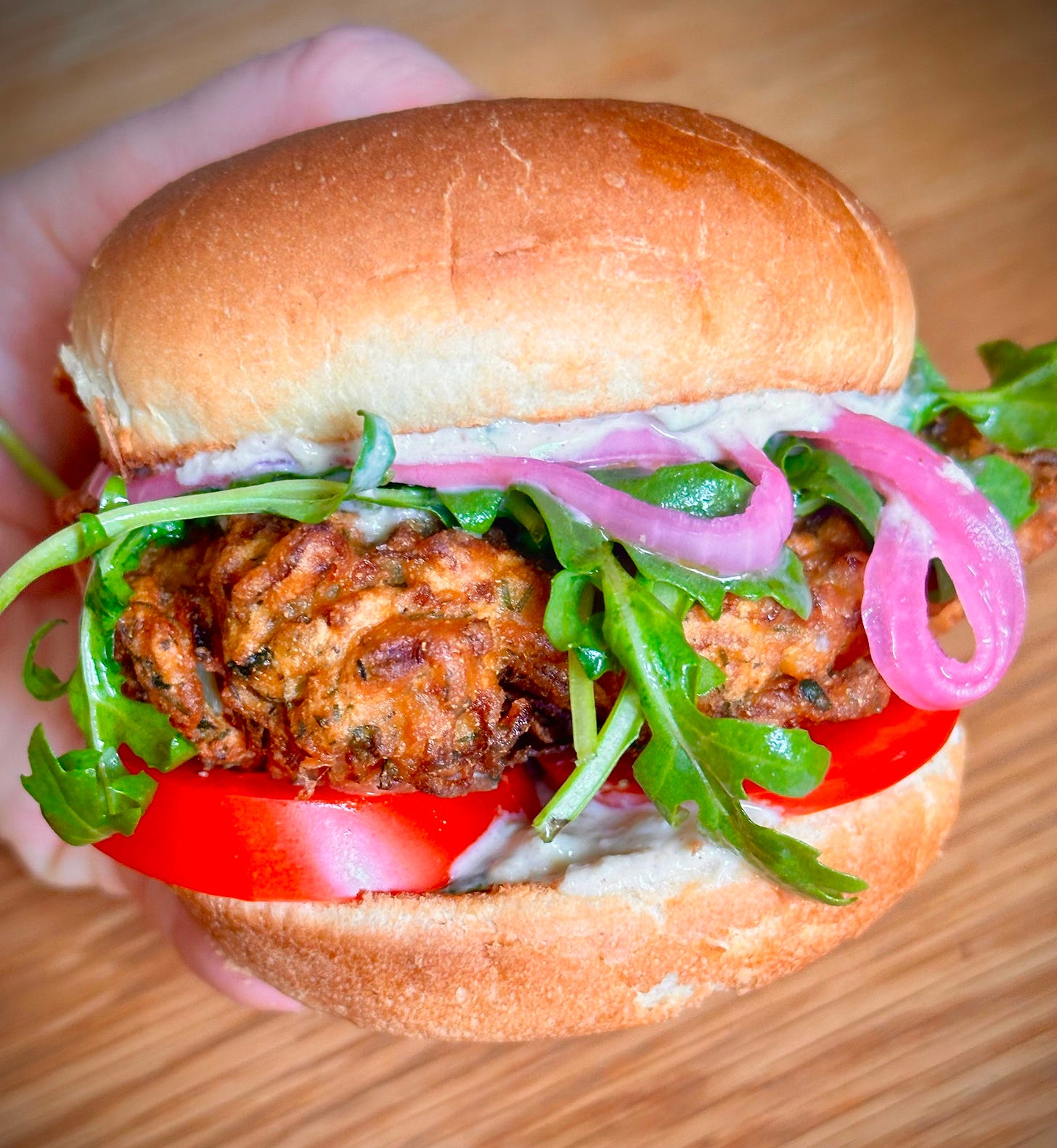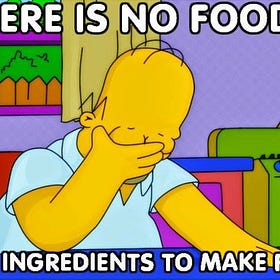Who's Afraid of Little Old MSG?
sometimes lies feel like the truth because they've been repeated enough
Hey Pot Heads! Like the rest of you, I’ve been reading the news and screaming into the void about all the dumb and terrifying shit going on right now in US. I know it’s a lot. The misinformation and outright propaganda all of us are wading through is caustic no matter how well we try to protect ourselves. It got me thinking about this piece I wrote last year about MSG and how lies can so quickly become accepted as reality through repetition and bad science. There are lots of new subscribers here (hiiiii) so I thought I would share this again. If you’re grocery shopping with an eye on stocking up on staples like olive oil, beans, and rice because of the tariffs and empty ports, throw a lil MSG in your cart. I can’t see the future but I know that having great tasting food at home will make everything a bit easier. Ok, let’s get into it.
Everybody thinks they know about MSG. Lots of people swear that they’re allergic. I’ve been in the vegan/wellness world for decades and I’ve never heard a kind word about it. Red No. 40, titanium oxide, artificial flavorings, and MSG are all listed in the same breath as things that must be avoided in our diet at all costs. But one of these things isn’t like the rest. There’s the phenomenon in the food and wellness worlds that if something is whispered about as “bad for you” then that’s as good as gospel. I don’t think that should cut it anymore. It’s ok to be suspicious but at a certain point, facts are required. If the facts don’t support our feelings, then our feelings need to change because being illogical is also bad for our health. The food and wellness worlds need to face their fears of MSG.
MSG, or monosodium glutamate, is the sodium salt of the common amino acid glutamic acid. Glutamic acid is naturally present in our bodies and in many foods we love to eat like tomatoes and onions. That’s right, a form of MSG is hiding right in your salad bowl, soy sauce, and walnuts. Yet 42% of Americans think it’s bad for them despite a lack of scientific evidence. So how did such a common flavor compound get such a bad rap? It’s a classic game of telephone- with a racist, xenophobic twist.
It all goes back to Kikunae Ikeda, a Japanese chemist at Tokyo Imperial University at the beginning of the 20th century. As the story goes, he was eating some soup at home with his family and started to wonder how his wife, Tei, had made a soup with no meat taste so… meaty. She knew what she had done but we don’t have her side of the story. Ikeda deduced that it was the seaweed, kombu, that gave the soup that indescribably depth. After spending weeks in his lab isolating the flavor compounds and evaporating seaweed broth, Ikeda made a breakthrough. Not only did he discover the fifth taste, umami, he also isolated the flavor into a crystalized compound similar in appearance to salt- MSG. There’s no umami without MSG and without Ikeda and his wife, we wouldn’t have either. He immediately saw that there was money to be made with this new discovery and in 1909, he began selling AJI-NO-MOTO, the first umami flavoring powder made from MSG isolated from fermented foods like soy, corn, beets, and molasses. The Ajinomoto Group is still a hugely popular brand, making over $10 billion in revenue just last year. In 1985, Japan named Ikeda one of the country’s Ten Greatest Inventors- a well-deserved honor.
Monosodium glutamate started appearing in everything that could use a little flavor boost. Pre-packaged, processed foods took off everywhere after World War II and MSG was brought along for the ride. Here in the US, it was in rations for our military, and in consumer-facing products like canned soups, crackers, ranch dressing, yogurt, and even baby food. It’s a staple in many sazon blends, the beloved seasoning mix used all over Mexico, Central, and South American countries and the Caribbean. Since there’s no chemical difference between the glutamic acid that’s found naturally in foods and that found in MSG, it was seen as a relatively healthy way to enhance the flavor of foods without adding more salt. Sure, the rest of the food product might be terrible for people, but MSG was just there to improve its taste. That’s what it does whether the food in question is healthy or not. There wasn’t an MSG panic in the US until late 60’s and it can be traced back to one initial cause.

In 1968 The New England Journal of Medicine published a letter from Dr. Robert Ho Man Kwok, a pediatrician from Maryland, describing something he called ‘Chinese Restaurant Syndrome’. He claimed that after eating at Chinese restaurants in the US he had noticed odd symptoms including “numbness in the back of the neck, gradually radiating to both arms and the back, general weakness, and palpitation.” Between the vague description of the feeling and the catchy, racist name, the letter struck a nerve. Suddenly, lots of other doctors wrote in describing similarly vague feelings after eating Chinese food. The topic of ‘Chinese Restaurant Syndrome’ was getting a lot of attention in the press and the scientific community was all too happy to make some evidence to support these claims. A handful of foundational studies came out in the years following the letter that “proved” it was MSG causing these short term and long term health issues. These studies have since been delegitimized for their faulty methodologies, and new ones have failed to find any substantial issues with MSG but the damage was already done. The story was in the zeitgeist. MSG was terrible and it was in all that funny food over there.
Something else was going on around the time of the MSG scare. In 1965, the United States finally lifted its race-based immigration quotas which had been used to limit the number of non-European immigrants that could come to the US. Between this change and the beginning of The Cultural Revolution in China in 1966, lots of Chinese immigrants moved to the US to start a new life. And like lots of immigrants to new places, many of them opened restaurants. White Americans, already scared of this new wave of immigrants and their food, needed a reason to justify their prejudice. It’s a story as old as time. So when an esteemed medical journal gave them an excuse that insulated their bigotry in science, it was a perfect fit.
But that can’t be why Dr. Kwok wrote that letter to The New England Journal of Medicine, right? Ready for the twist? He’s as real as the symptoms he described.
There’s no Dr. Kwok and no syndrome from MSG. Period. Read that again. In the last 10 years, the truth has come out thanks to researchers who realized something wasn’t adding up. It was a bunch of racist doctors goofing around in a medical journal and then an uncritical press just took the story and ran with it. Yes, really. Dr. Howard Steel, an orthopedic surgeon, wrote the letter on a dare from fellow doctor Bill Hanson after the two had been eating Chinese food and drinking all night. Hanson bet Steel that he could never get published in The New England Journal of Medicine because Hanson, a doctor of internal medicine, didn’t think much of Steel’s branch of healing. Instead, Steel wrote a frat-prank style letter to the journal’s Correspondence section and he thought the signature would give it away. “I didn't sign it with my name, but I signed it Ho Man Kwok-- H-O, one word, M-A-N, one word, Kwok, K-W-O-K, figuring that someone, when they got this letter, would realize that what that word was a breakdown of a not nice word we used to use all the time when someone was a jerk. We call him a human crock of you know what.” Then it got published and despite claiming to have called the journal several times to get it retracted, Dr. Steel didn’t go public until well after he retired. He had won the bet. And here we are, 52 years later, still scared of MSG.
We need to do better. Jennifer LeMesurier did an amazing study that illustrates how what happened to MSG happens with us all the time. “The case of MSG is exemplary of how racist views can become intertwined with views of an otherwise amoral material substance. Even when the original context fades away, there are still ideological dangers in uncritically accepting these now naturalized conclusions.” MSG isn’t more unhealthy than salt or sugar. The poison is in the dose for all three. Its presence in highly processed foods is also just guilt by association. We all know salt is bad in big amounts but that doesn’t mean we don’t put a pinch into what we cook. MSG should be the same. Highly processed foods are not good for us for a whole host of reasons, but the passing presence of MSG is the least of it. Umami is what makes our food have more depth and it’s that depth I’m looking for when I add soy sauce or nooch to a recipe. We eat natural sources of glutamic acid constantly so why draw the line at the crystalized version? It doesn’t make sense, unless you want to hold on to old ideas.
MSG seems like an ingredient vegan and vegetarian home cooks should embrace. It isn’t animal derived and a bag of it often retails for less than $5 which will last you months if not years. It’s total fine in normal doses, makes home cooked meals taste better, and is extremely affordable. Do I think everything you cook needs MSG in it? Hell no. But do I think it deserves a more critical examination to get a place in your pantry? Hell yes I do. Sprinkle it on some finished tofu, add a pinch to your soup, fold a little into your next batch of refried beans. You’ll be surprised how far it goes. Don’t let outdated thinking hold you back in life or in the kitchen. MSG deserves some respect even if you don’t run out and grab a bag.
What other outdated foods belief are we still holding on to that need to go? Did you know all of this about MSG? Let me know in the comments!
Tomorrow, the paid subscribers are getting my last round of recipes for chickpea flour including this burger that’s going to be heavy in my rotation this summer. Trust me, you need to put chickpea flour on your grocery list because it’s delicious, versatile, and one bag will get you several meals. I’ve got plenty of recipes for you, you just got to grab your ingredients. Not on the Sunday list? Fix that please, we’ve saved you a seat!
xoxo,
Michelle
Ultra-Processed Love
Happy Father’s Day weekend everybody! As an early thank you, I wanted to announce the winners of the paid subscriber gift boxes. These boxes are filled with some on my favorite foods and kitchen accessories. No ads or sponsored content, just stuff I love, made or purchased by me. So congrats to winners:
Cook It Out
When the color runs out of the world, food loses taste. My cravings, usually so razor sharp, dulled as the election result rolled in. My endless hunger left me. I just laid on the couch, staring out the window. I won’t dwell on politics, we’re all so tired. It feels like all the love you pour into building your future …










I have a friend who swears he’s allergic to msg with no true backing. I don’t question allergies usually. It’s not my business what you put in your body, but this one gets me. We have a mutual friend that makes tamales locally. We all eat them (including this friend). I decided I wanted to learn to make Costa Rican tamales so I joined them for their most recent weekend of cooking. Guess what’s inside. I haven’t told them that they are eating msg, but I think it might be time to share your article and have a conversation.
I love when this gets brought back up from time to time and the real story is shared. It was absolutely just racist Drs having a laugh but peoples worst nature took over and it was believed. MSG makes food taste better, period. I’m all for it and the people that think it’s bad for them or that they are “allergic” can pound sand 🙄